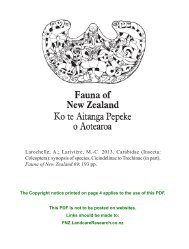Fauna of NZ 45 - Landcare Research
Fauna of NZ 45 - Landcare Research
Fauna of NZ 45 - Landcare Research
You also want an ePaper? Increase the reach of your titles
YUMPU automatically turns print PDFs into web optimized ePapers that Google loves.
18 Kuschel (2003): Nemonychidae, Belidae, Brentidae (Insecta: Coleoptera)<br />
Male. Tergite 8 partially exposed beyond 7, simple,<br />
lacking transverse carina, with basal angles incurved mediad.<br />
Sternite 8 almost entirely membranous, with a long, fine,<br />
Y-shaped apodeme. Sternite 9 with a Y-shaped, weakly<br />
upcurved apodeme. Tegmen with a small, paucisetose<br />
parameral sector. Aedeagus with a sclerotised pedon and a<br />
narrow, weakly pigmented tectum; pedon in lateral view<br />
angularly protruding dorsally and ventrally at base;<br />
apodemes articulating in basal emargination <strong>of</strong> aedeagal<br />
body, with a narrow bridge across connecting apodemes;<br />
internal sac usually with a pair <strong>of</strong> sclerites and with spinules<br />
<strong>of</strong> varying sizes on walls; ejaculatory duct insertion dorsal<br />
at base.<br />
Female. Ventrite 5 with a small setiferous pit on<br />
either side. Sternite 8 sclerotised at centre, lacking a fork.<br />
Vagina and bursa long, <strong>of</strong> similar length; distal hemisternites<br />
slender, cylindrical, with a very small, bulbous lateroapical<br />
stylus (Fig. 43); spermatheca as in Fig. 44, broad at either<br />
end, with a short, slightly expanding gland; spermathecal<br />
duct nearly as long as vagina and bursa combined, inserting<br />
ventrally on bursa a short distance from oviduct.<br />
Distribution. New Zealand endemic: North Island, South<br />
Island, Stewart Island.<br />
Host plants. Phyllocladaceae, Podocarpaceae.<br />
Remarks. A genus with four species, one ubiquitous (R.<br />
rufulus), the others geographically apparently more confined<br />
and in the main submontane or montane. Judging by<br />
the association with Podocarpaceae, the exclusive crawling<br />
<strong>of</strong> larvae on their venters at all stages <strong>of</strong> development, and<br />
the pubescence <strong>of</strong> the rostrum directed basad,<br />
Rhinorhynchus shares with the Chilean Nannomacer<br />
Kuschel more features than with the Australian Basiliogeus<br />
Kuschel and Basiliorhinus Kuschel, which live on<br />
Araucariaceae, have larvae that crawl at all stages on their<br />
backs, and have the pubescence <strong>of</strong> the rostrum directed<br />
forward. All four species <strong>of</strong> Rhinorhynchus are found on<br />
Phyllocladus. These same four can occur on most, if not<br />
all, podocarpaceous species, thus the range <strong>of</strong> hosts is<br />
wide. In this respect Rhinorhynchus differs remarkably<br />
from Nannomacer, its counterpart from Chile, where each<br />
species is confined to one podocarpaceous genus.<br />
Biology. The life cycle <strong>of</strong> Nemonychidae was inferred in a<br />
paper (Kuschel 1983) from observations <strong>of</strong> the habits <strong>of</strong><br />
Rhinorhynchus rufulus. Adults are found throughout the<br />
year. They are especially abundant around the time <strong>of</strong><br />
hosts exhibiting nearly or fully mature male strobili (cones),<br />
usually from September to December, when eggs are laid.<br />
Adults feed on pollen. Larvae start to appear on male<br />
strobili a week or two before pollen is released, feeding on<br />
pollen and sporophylls. They move rather actively on the<br />
surface <strong>of</strong> the strobili (Fig. 168) and between the<br />
sporophylls (scales), dropping to the ground at the end <strong>of</strong><br />
their development to pupate in the soil. They emerge from<br />
May onwards.<br />
Key to species <strong>of</strong> Rhinorhynchus (Nemonychidae)<br />
1 Elytra at basal half densely, coarsely punctate, appearing<br />
multistriate because <strong>of</strong> a row <strong>of</strong> coarse puncta on<br />
interstriae (Fig. 1). Vestiture on elytra dense, coarse,<br />
subsquamiform, concealing most <strong>of</strong> integument. Length<br />
1.5–2.7 mm. Ubiquitous from Northland to Stewart<br />
Island ............................................. (p. 19) ... rufulus<br />
—Elytra at basal half neither densely nor coarsely punctate,<br />
appearing simply striate because <strong>of</strong> only fine puncta<br />
on interstriae (Fig. 2). Vestiture on elytra sparse, fine,<br />
leaving most <strong>of</strong> integument exposed ........................ 2<br />
2(1) Antennae reaching eyes with segment 3 in both sexes;<br />
at least last antennal segments black or nearly so. Head<br />
abruptly constricted towards rostrum (Fig. 21, 22),<br />
basal part <strong>of</strong> rostrum cylindrical or subcylindrical in<br />
both sexes. Mandibles angulate or strongly curved on<br />
outer margin alongside terminal seta <strong>of</strong> laterodorsal row<br />
<strong>of</strong> punctation (Fig. 22). 1.5–2.2 mm. Coromandel,<br />
Subalpine Taupo, Nelson, Otago Lakes ....................<br />
................................................... (p. 20) ... halocarpi<br />
—Antennae reaching eyes with segment 4 in male, with<br />
segment 5 in female, reddish throughout although club<br />
usually a shade darker. Head more gradually constricted<br />
towards rostrum (Fig. 23–26), basal part <strong>of</strong> rostrum<br />
distinctly tapering towards antennal insertions in both<br />
sexes. Mandibles gently curved throughout on outer<br />
margin ...................................................................... 3<br />
3(2) Smaller, usually under 2.3 mm. Segment 2 <strong>of</strong> antennal<br />
club not longer than wide, usually distinctly transverse.<br />
Rostrum in lateral view distinctly more curved in both<br />
sexes. Male: eyes moderately convex; tibiae more<br />
robust, distinctly incurved at apex; tegmen with<br />
slenderer parameres (Fig. 39); aedeagus (Fig. 37, 38)<br />
slender, less than 0.10 mm wide, with main body 5x<br />
longer than wide, with apodemes about half length <strong>of</strong><br />
aedeagal body, with sclerites in the internal sac small<br />
(Fig. 37). Length 1.60–2.35 mm.Northland, Auckland,<br />
Taupo, Hawkes Bay, Buller ... (p. 20) ... phyllocladi
















